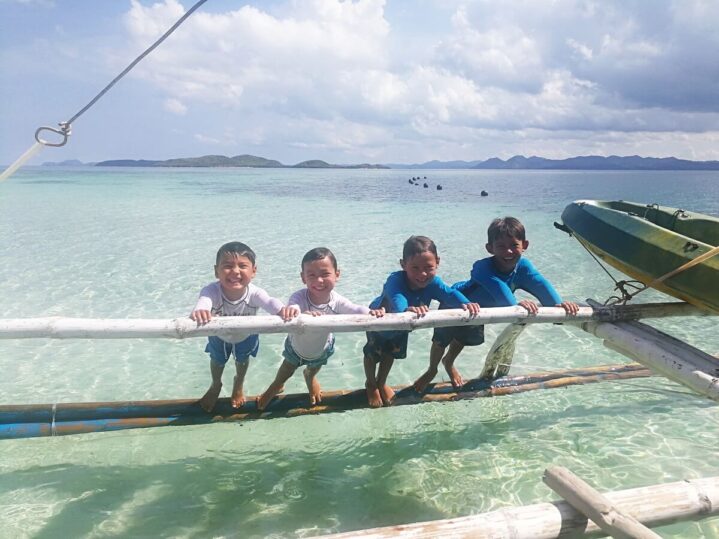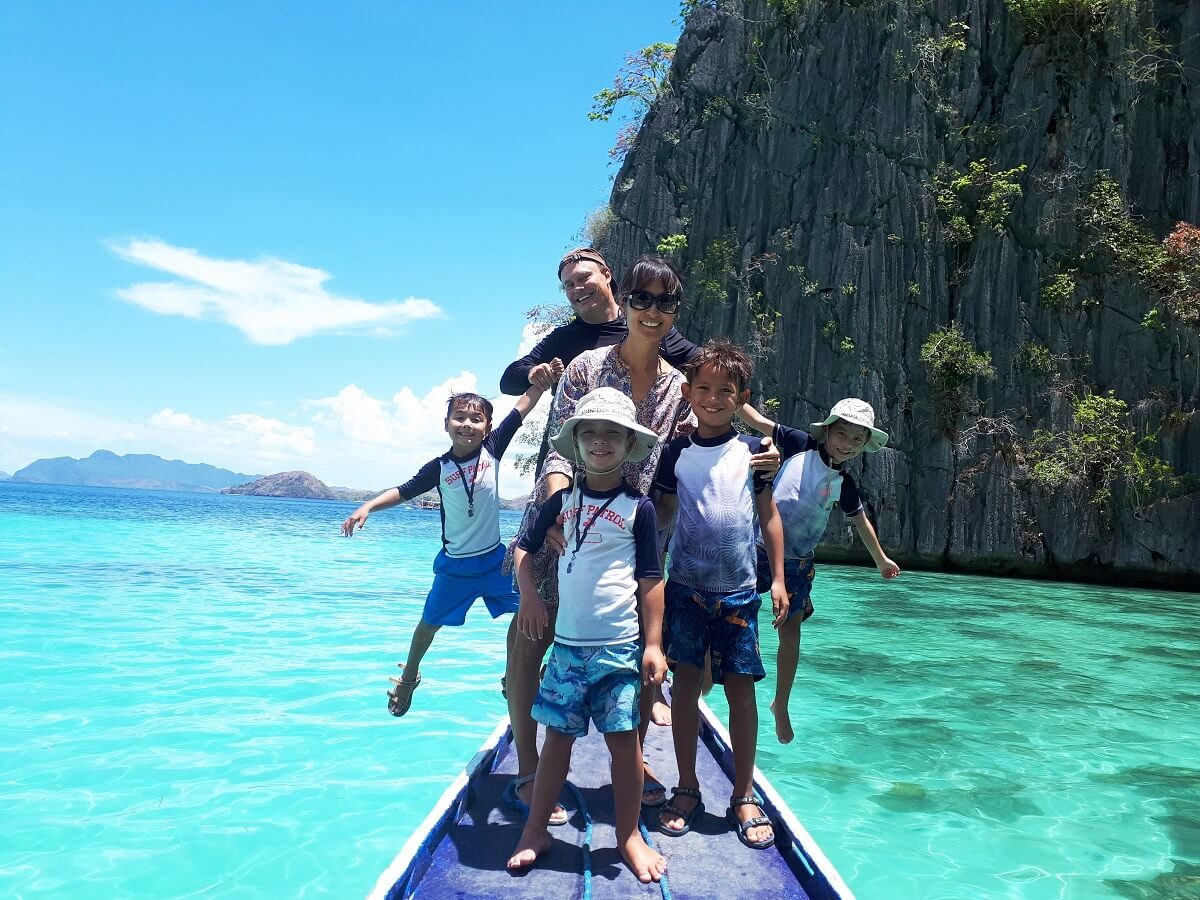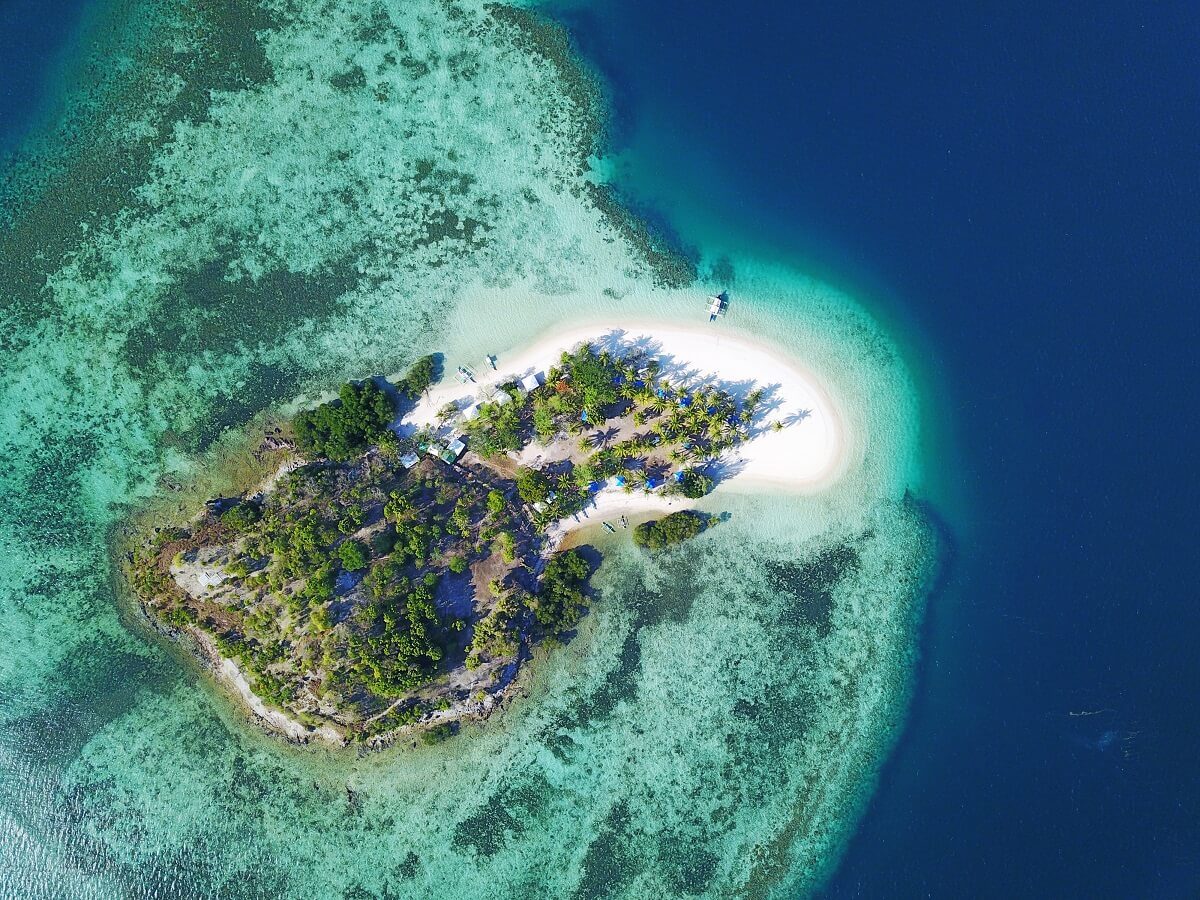
The beauty of Coron Island
by Scott and Nori
CORON ISLAND was a fortress of jagged, Jurassic limestone. From a distance, it looked impregnable. As our bangka motored closer, however, emerald coves and concealed passages came into view. We are karst connoisseurs – having climbed, sailed and spelunker these fantastical formations from China’s Yangshuo and Vietnam’s Ha Long to Thailand’s Phang Nga. Coron Island exceeded them all: bigger, sharper, clearer, cleaner – and more threatened.
I was glad that I had done my research. Most tours use charmless, chaotic Coron Town as a base for exploring Coron and dozens of other islands around the bay. That seemed sensible until I discovered that Coron Town isn’t even on Coron Island, which is at least a 20 minute boat ride away. That presented three problems. First, we’d waste a lot of time getting to Coron Island and back every day. Second, our ability to travel further afield would be limited. Third, everybody else would be doing the exact same thing.
Averse to crowds and eager to explore beyond Coron, we booked a 3D/2N cruise with Big Dream Boat Man. We’d stay on a different island each night and visit places before or after the day tours came. Chino, our cheerful and laidback guide, met us at the hotel in the morning. It was obvious that he had a son too; he was an absolute natural with the boys. We climbed into two very odd shaped trikes and rattled down Coron Town’s main road towards the port.

Our boat for the next three days was a bangka – a photogenic Filipino vessel that looks like an X Wing Fighter coming at you or like a water strider from above. Essentially a big canoe with twin outriggers, deck space was extremely limited. After cruising on the spacious Sea Gipsy in the Mergui Archipelago and the Carpe Diem in Komodo, we couldn’t hide our disappointment when we first saw it. I wasn’t sure how all six of us and our bags were going to fit. It certainly wasn’t going to be comfortable.
As it turned out, the boat was fine because the crew was fantastic. No journey was longer than a few
hours and the scenery en route was magnificent. Chino found us lesser-known snorkeling spots and empty beaches. Our chef whipped-up delicious, hearty meals in a kitchen the size of a gym locker. Pan-fried grouper with roasted potatoes and bacon bits? The freshest fried calamari? And while there were no G&Ts on the sundeck, there were plenty of T&Cs (Tanduhay & Cokes) on the outrigger struts.
We decided to save Coron Island’s most-famous locations for last. Instead, we sailed south down the island’s west coast, stopping to swim and drink freshly-chopped coconuts at tiny, immaculate Smith Beach. Next, we explored a concealed cave. And after a long swim and snorkeling session, we ate lunch at a bamboo -and-thatch hut built into the cliffs near Sunset Beach. Then Nori and the boys napped as the captain headed southwest across the width of Coron Bay.
When we arrived on pretty little Banana Island in the late afternoon, there were five other boats anchored offshore and a few dozen tourists sunning on the beach or dozing in hammocks. I didn’t realize that they
were day-trippers. But within an hour,they were all gone! I flew the drone over the island and across the channel towards the Two Seasons Hotel on Bulalacao Island. The boys borrowed bicycles and slalomed through the palm trees. Then the six of us went for a long snorkel.
It had been an amazing day, but it was a terrible night of sleep. The electricity went off some time after midnight, bringing the ancient, fuzz-covered fans to a halt. I stumbled around in the dark, trying to locate the magic switch. Eventually, I gave up and crawled back under the mosquito netting. But it was already too hot for me to sleep, and without the whirr of the fan I could hear small animals scampering about in the rafters. Pastor Hermi met us at Culion port. He was tall, tan and wore wraparound sunglasses. He looked more like a beach volleyball player than a man of the cloth and tour guide, but he was passionate about unearthing and sharing Culion’s surprisingly rich history. We piled into a motorized trike and zipped uphill
towards the old Spanish fort. The beautiful Church of the Immaculate Conception had been built on and amongst the defensive walls. Inside, two women were dusting the pews and arranging flowers for a wedding later that day. Exiting through a side door, we climbed up to a battlement with a commanding view over the island-studded sea.
“See that cannon?” Hermi asked Drake and Kiva. “See that narrow place where the boats can come into the city? That’s where the cannon is pointing; to protect the city from invaders.”
Drake and Kiva were fascinated.
“Who were the invaders?”
“Well, at that time, mostly Muslims,” Hermi replied. “The Spanish wanted to protect their fort and their church. Remember, before the Spanish came and brought the Catholic faith, most of the people in this area of the Philippines were Muslim.”
A short walk away were the lemon-coloured walls of the Culion Sanitarium and Hospital. A hundred years ago, this was the largest leprosarium (leper colony) in the world, designed by the Americans to isolate the afflicted, prevent the spread of and eventually eradicate the disease.
Today, it’s an important medical centre for the region. “We get patients from Busuanga, Palawan, all over.
It’s amazing to think that this hospital has changed from a ‘place of no return’ to a place where people are cured!”

After sailing north through a maze of tightly-packed islands, we moored beside the wreck of the Terukasi Maru, sunk by US planes in WWII. The boat lay on its side in relatively shallow water, its stern only a metre below the surface. After eighty years submerged, the Terukasi Maru was now a ship-shaped coral reef teeming with life. Wreck snorkeling was a new experience for the boys and they were utterly captivated.
Our family had a good hour floating alone above the ship and freediving down to get a closer look. Then suddenly, four boats from Coron Town showed up and we shoved off.
Our second evening was spent on stunning Pass Island, a low hump of green with a tongue of the whitest sand extending into the light blue water. Hoover, the island’s loveable resident chocolate lab, was the first to greet us. Chino said that the island gets over100 guests daily, mostly day-tours from Busuanga and Coron Towns. But it was already 4pm, so we had the island to ourselves (again). While the boys played Uno with Chino and cavorted with Hoover, Nori and I followed a path up and over the knoll to the other side of the island. The sky was filled with ragged clouds that lit up magically as the sun dropped behind dozens of islands.
A GLORIOUS SLUMBER recharged our bodies and spirits. We woke to the peaceful sounds of palm
fronds high-fiving above our bamboo hut and tiny waves caressing the sand. The last day. Sigh. After a ‘clear-out-theleftovers’ breakfast of gristly beef tapa, bright red hot dogs and fried rice, Nori and I snorkelled one last time in the exceptionally clear water. The boys were giving Hoover belly-rubs and jumping from the outriggers. It was one of the finest mornings of our six-month trip.
Towering Coron Island – always visible throughout our cruise – was a two-hour sail east back across Coron Bay. But an hour into the journey, we heard a loud grinding noise from the stern, followed by a BONK! Our transmission had broken. We’d have to wait an hour for a replacement boat to arrive from Coron Town.
“Time for fishing!” Chino shouted, killing the tension.
While I fished Filipino-style – a hand-line wrapped around a joint of bamboo, a section of rebar for a sinker – the boys jumped overboard, turning the bangka’s outriggers and struts into a jungle gym. There was no point in getting upset. Our overnight ferry to Manila left tomorrow afternoon, the kids were having a great time and there was plenty of Tanduhay rum and Coke in the cooler box. An hour later, we and Chino were on a new boat with a new crew, heading for Coron.

After the splendid isolation of Pass Island, Twin Lagoon was something of a shock: eight bangkas crammed into a small cove. You could swim to a bamboo ladder and climb up over the low saddle between the two lagoons (a favourite IG spot), or you could swim through a nearly submerged tunnel tothe other side. We swam, together with a group of 20 comically unfit Filipinos who linked arms and legs and were towed backwards into the lagoon by their beefy guide. Coron’s serrated cliffs towered above us, carving a circle of blue from the sky.
The dozens of bangkas lined up under the cliffs near Kayangan Lake



